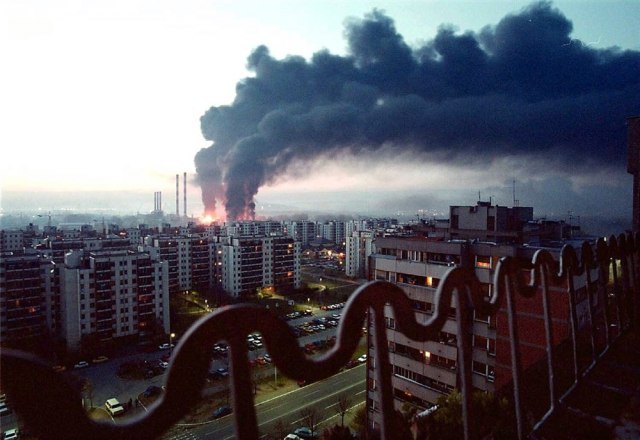Serbia marks 24 years since the beginning of NATO aggression
24 years ago, on March 24, 1999, NATO aggression against Serbia, that is, the Federal Republic of Yugoslavia, started.
Friday, 24.03.2023.
07:53

Serbia marks 24 years since the beginning of NATO aggression
The order for the attack was issued by Javier Solana, the Secretary General of NATO at the time, to the then commander of the allied forces, US General Wesley Clark, although there was no UN Security Council approval. It was an obvious precedent.It is estimated that in July 1998, the so-called KLA (Kosovo Liberation Army) controlled approximately 40 percent of Kosovo and Metohija. At that time, there were more than 20,000 people in its composition. During this period, they control rural areas and obstruct roads. Attacks on the police, who were trying to guard traffic routes, important points, facilities and urban environments, happened on a daily basis. The Yugoslav Army was forced to help the police during the unblocking of Dečani in June 1998, and Orahovac in July 1998. By October, the police managed to liberate a number of villages in the central part of the province.
At the same time, there was a harsh campaign against Serbia in the Western media. There was, so to speak, a flood of untrue information about the events in Kosovo and Metohija. In the book "Modern Warfare", Wesley Clark later revealed that the planning of the NATO aggression against the FRY "was well underway in mid-June 1998" and that everything was ready a few months later.
The Council of the North Atlantic Alliance (NATO) on October 12, 1998, made a decision on the adoption of the order for the activation of forces. An agreement between Slobodan Milošević and Richard Holbrooke followed the next day. It is planned to reduce the number of soldiers of the Yugoslav Army in the territory of Kosovo and Metohija to the number from the beginning of 1998. It has been agreed that OSCE observers will monitor the situation, that is, the peace process in Kosovo and Metohija. The agreement also stipulated that no person would be prosecuted in state courts for crimes related to the conflict in Kosovo, except for crimes against humanity and international law.
After the meeting of the NATO Council on January 30, 1999, it was officially announced that NATO was ready to launch strikes against the FRY. The NATO aggression was preceded by insincere offers from the international community, as well as the deployment of additional NATO troops in Albania and Macedonia. Negotiations in Rambouillet were conducted from February 6 to March 19.
The FRY delegation did not sign the final text offered. This was followed by another arrival of Richard Holbrooke in Belgrade on March 22 for negotiations with Slobodan Milošević. The media reported that this last peace attempt also failed.
The level of demands sent to official Belgrade, which was confirmed even by Madeleine Albright, was raised all the time during the so-called negotiations, so that Serbia would be blamed. As interpreted by Vladislav Jovanović, announcements of the bombing had existed for ten years, since the time when Bob Dole promised independence in Pristina. Bill Clinton, the then president of the USA, told the delegation of American Serbs that he would not sign what was offered to Milosevic. A similar view was later expressed by Henry Kissinger.
FRY was attacked as the alleged culprit for the humanitarian disaster in Kosovo and Metohija. The immediate cause, actually the justification, were the events in Račak on January 15. And then the failure of the alleged negotiations conducted in Rambouillet and Paris. In reality, it was support for the terrorist organization of the Kosmet Albanians, the so-called KLA, which by then had already committed numerous crimes.
After the Serbian Parliament confirmed that it does not accept the decision on foreign troops on its territory and proposed that United Nations forces monitor the peace settlement in Kosovo and Metohija, NATO began airstrikes.
According to the first announcement of the General Staff of the Yugoslav Army, on March 24 at around 8:45 p.m., more than twenty objects were targeted in the first raid. The first missiles fell on the barracks in Prokuplje at 19:53. This was followed by an attack on Priština, Kuršumlija, and Batajnica.
On the same evening, US President Bill Clinton announced the need to "demonstrate NATO's seriousness in opposing repression", stressing the need to "intimidate Serbia and Yugoslavia" and "destroy Serbia's military capacities", so that, as he said, "actions against the Kosmet Albanians would not be taken". That same evening, British Prime Minister Tony Blair said that the NATO aggression was undertaken because "the people of Kosovo" asked for it. In order to further clarify that, by "the people of Kosovo" he means Kosmet Albanians.
Nineteen NATO countries began bombing from ships in the Adriatic, as well as from four air bases in Italy. First of all, the anti-aircraft defense and other facilities of the Yugoslav Army were targeted.
According to the data of the Ministry of Defense of Serbia, 2,500 civilians were killed during the NATO air aggression, among them 89 children and 1,031 members of the Army and police. According to the same source, around 6,000 civilians were wounded, of which 2,700 were children, as well as 5,173 soldiers and policemen, and 25 people were missing.
According to Serbian experts, 18,168 air takeoffs were recorded until June 10. According to NATO sources, there were 38,004 air surges, of which 10,484 were fire actions, while the rest were reconnaissance, anti-aircraft, and tankers. At first, around 70 fighter planes took part in the operations daily, and later that number was around 400 on a daily basis.
NATO's war losses in manpower and technology are denied. The then authorities in Belgrade claimed that more than a dozen aircraft were shot down, which was not confirmed. The Russian agency APN announced that NATO had lost over 400 soldiers and over 60 aircraft, while US President Bill Clinton stated in a speech on June 10, 1999 that NATO had suffered "no casualties". Aircraft F-117, F-16, unmanned aerial vehicles, cruise missiles, aircraft F 117, the so-called "invisible" until then symbol of the superiority of American technology, ended up in a field of the Srem village Budjanovci.
There is almost no city in Serbia that was not targeted during the 11 weeks of aggression. NATO carried out 2,300 strikes and dropped 22,000 tons of missiles, including 37,000 banned cluster bombs and those filled with enriched uranium. Apart from attacks from ships in the Adriatic, as well as from four air bases in Italy, operations were carried out from bases in the countries of Western Europe and the USA.
Infrastructure, economic facilities, schools, health institutions, media outlets, cultural monuments, churches and monasteries were destroyed, totaling about 50 percent of Serbia's production capacity. Various data were presented about the material damage caused during the NATO aggression. The then authorities in Belgrade estimated it at approximately one hundred billion dollars, the group of G17 economists estimated the damage at 29.6 billion US dollars.
In the bombing, 25,000 residential buildings were destroyed and damaged, 470 kilometers of roads and 595 kilometers of railways were disabled. 14 airports, 19 hospitals, 20 health centers, 18 kindergartens, 69 schools, 176 cultural monuments and 44 bridges were damaged, while 38 were destroyed.
A third of the country's electricity capacity was destroyed, two refineries in Pancevo and Novi Sad were bombed, and NATO forces used graphite bombs for the first time to disable the electricity system. The overall consequences for the health of the population and the ecological consequences are immeasurable.
The Chinese embassy in Belgrade was destroyed on May 7, 1999. The RTS building in Belgrade was destroyed on April 23. 16 people died and the same number were wounded. The Novi Sad Television building was hit on May 3, 1999, on the International Day of Media Freedom.
The aggression was stopped with the signing of the Military-Technical Agreement in Kumanovo on June 9, 1999, and the withdrawal of FRY forces from Kosovo and Metohija began three days later. The agreement determined the withdrawal of the military security forces of the FRY from Kosovo and Metohija, and the establishment of UNMIK, a United Nations mission.
On June 10, 1999, the Secretary General of NATO issued an order to stop the bombing. The last projectiles fell in the area of the village of Kololeč, not far from Kosovska Kamenica, at 1:30 p.m., and on the barracks in Uroševac around 7:35 p.m. It was the 79th day of the NATO aggression against Serbia, that is, the FRY.
The UN Security Council then adopted Resolution 1244. 37,200 soldiers from 36 countries were deployed and sent to the province as part of the KFOR mission.




















































Komentari 4
Pogledaj komentare